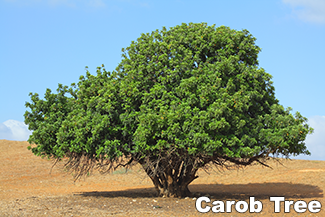Tree of the Month: Carob Tree
John Eisenhower of Integrity SavATree talks about the Tree of the Month, the Carob Tree and our Monthly Tree Topic: #FertilizePalms
Tree of the Month: #carobtree
Landscape Use: Dense shade tree for xeric landscape design themes.
Form & Character: Round and spreading canopy, rugged, leathery and coarsely branched.
Growth Habit: Woody, evergreen perennial tree, moderately-fast growing to 30 to 40 feet with greater spread. Prolific producer of basal trunk and root suckers.

Foliage/Texture: Alternate, leathery, even pinnately compound leaves, 4 to 6 inches long, leaflets in pairs of 2 to 3, leaflets are orbicular to obovate, petioles and rachis are reddish; medium coarse texture.
Flowers & Fruits: Carob tree flowers are bisexual, yellowish green maturing to red in color, and are arranged in short lateral racemes during the late fall and early winter on short inner spur branches of the tree. Often flowers exude a powerful musty fragrance (like dead fish, wet dogs, or musky perfume). Carob tree fruit are a flattened, twisting, and elongated pod to several inches long, green when immature but then maturing to a dark brown color. The pulp between the seeds inside mature fruit pods is edible, tasting like chocolate.
Seasonal Color: None
Tree Care
Temperature: This tree thrives in the heat of the lower desert.
Light: Full sun
Soil: Tolerant of moderate soil alkalinity, but will show foliar chlorosis in alkaline soils if the soils are chronically wet as might be the case around lawns.
Watering: Though drought tolerant, carob tree must have at least some deep, but infrequent irrigations during summer.
Pruning: Conservatively raise the crown base as needed and remove any epicormic shoots (sucker growth).
Propagation: Seed
Disease and pests: Trunk, crown and root wood rotting fungi are common.
Additional Carob Tree Information
Carob tree is a wide spreading tree. In Phoenix, carob tree is one of the best trees for casting a dense shade where water resources are limited. Carob tree does however have a 'few skeletons in its closet'. It has roots that are known to be invasive and its flower, fruit and leaf litter can be a debris problem in this age of the 'immaculate landscape'. It also has the potential in the presence of canopy cover and moist soil to reseed in Phoenix urban landscapes. Presently, carob tree is not popular in the Phoenix nursery/landscape trade.
Commercial carob chocolate is derived from the fruit pods. The carob tree fruit are sometimes referred to as "locusts" or "St. John's Bread." The Bible records in Mark 1:6 that John the Baptist ate "locusts and wild honey" as part of his simple vegetable diet. Even today carob continues to be an important feed for livestock. The word carat, which is still used today to measure gold and diamonds, comes from the Arabic name for the carob seeds because of their uniformity in weight.
Broadcast Caller Question: There are small holes in my Carob Tree - is this normal or is something wrong with my tree?
Answer: Yes this is normal. So normal in fact, that it is almost a characteristic of carob tree. More often than not, you will find mature Carob trees that are covered in small perforations. These small perforations are woodpecker holes!
The Carob tree is very sweet, so sap suckers like the woodpecker love to peck them. When they do, the tree releases a little bit of sap for feeding. They will tap and make a hole, eat the sap that is released then do it again another inch or two over. Tune in below for more in depth explanation.
For more info visit the Virtual Library of Phoenix Landscape Plants by Chris A. Martin, Ph.D., Professor Emeritus of Horticulture at Arizona State University.
Home Maintenance Calendar | #CarobTree
Podcast
Expert John Eisenhower discuss the Tree Of The Month: The Carob Tree! An evergreen shade tree most landscapes never think about. And yes, its pods are edible and can be used for cocoa. Plus tips on fertilizing palms and listener questions including help with an ailing aleppo pine, watering a young red push pistache, pruning a chilean mesquite and a mystery solved! What are the holes in the trunk of my carob tree?
###
